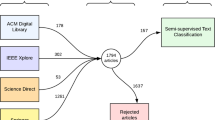Abstract
Legislation usually lacks a systematic organization which makes the management and the access to norms a hard problem to face. A more analytic semantic unit of reference (provision) for legislative texts was identified. A model of provisions (provisions types and their arguments) allows to describe the semantics of rules in legislative texts. It can be used to develop advanced semantic-based applications and services on legislation. In this paper an automatic bottom-up strategy to qualify existing legislative texts in terms of provision types is described.
Similar content being viewed by others
References
Apté C., Damerau F. J., Weiss S. W. (1994) Automated Learning of Decision Rules for Text Categorization. ACM Transactions on Information Systems 12(3):233–251
Bartolini, R., Lenci, A., Montemagni, S., Pirrelli, V., and Soria, C. (2004). Automatic Classification and Analysis of Provisions in Italian Legal Texts: A Case Study. In Proceedings of the Second International Workshop on Regulatory Ontologies.
Biagioli, C. (1991). Definitional Elements of a Language for Representation of Statutory. Rechtstheorie 11.
Biagioli, C. (1992). Law Making Environment. In Proceedings of Workshop on Legal Knowledge and Legal Reasoning Systems, Tokyo.
Biagioli, C. (1997). Towards a Legal Rules Functional Micro-ontology. In Proceedings of Workshop LEGONT ’97.
Biagioli, C., and Francesconi, E. (2005). A Semantics-based Visual Framework for Planning a New Bill. In Proceedings of the Jurix Conference: Legal Knowledge and Information Systems, 103–104.
Biagioli, C., Francesconi, E., Passerini, A., Montemagni, S., and Soria, C. (2005a). Automatic Semantics Extraction in Law Documents. In Proceedings of International Conference on Artificial Intelligence and Law, 133–139.
Biagioli, C., Francesconi, E., Spinosa, P., and Taddei, M. (2005b). A Legal Drafting Environment Based on Formal and Semantic XML Standards. In Proceedings of International Conference on Artificial Intelligence and Law, 244–245.
Biagioli, C., and Turchi, F. (2005). Model and Ontology based Conceptual Searching in Legislative XML Collections. In: Proceedings of the Workshop on Legal Ontologies and Artificial Intelligence Techniques, 83–89.
Bishop C. (1995) Neural Networks for Pattern Recognition. Oxford, Oxford University Press
Boer, A., Hoekstra, R., and Winkels, R. (2002). MetaLex: Legislation in XML. In Proceedings of JURIX 2002: Legal Knowledge and Information System, 1–10.
C. Buckley, G. Salton (1988) Term-weighting Approaches in Automatic Text Retrieval. Information Processing and Management 24(5):513–523
Burges, C. (1998). A Tutorial on Support Vector Machines for Pattern Recognition. In Data Mining and Knowledge Discovery, Vol. 2, Kluwer Academic Publishers: Boston.
Cortes C., Vapnik V. (1995) Support Vector Networks. Machine Learning 20:1–25
Crammer K., Singer Y. (2002) On the Algorithmic Implementation of Multiclass Kernel-based Vector Machines. Journal on Machine Learning Research 2:265–292
Dumais, S., Platt, J., Heckerman, D., and Sahami, M. (1998). Inductive Learning Algorithms and Representations for Text Categorization. In CIKM ’98: Proceedings of the Seventh International Conference on Information and Knowledge Management, 148–155, ACM Press: New York, NY, USA.
Hsu, C.-W., and Lin, C.-J. (2002). A Comparison of Methods for Multi-class Support Vector Machines. IEEE Transactions on Neural Networks 13(2): 415–425.
Jensen, F. (1996). Introduction to Bayesian Networks. Springer-Verlag.
Joachims, T. (1997). A Probabilistic Analysis of the Rocchio Algorithm with TFIDF for Text Categorization. In Proceedings of the Fourteenth International Conference on Machine Learning, 143–151, Morgan Kaufmann Publishers Inc.
Lee, Y., Lin, Y., and Wahba, G. (2001). Multicategory Support Vector Machines. Technical Report 1043, Dept. of Statistics, University of Wisconsin.
Lewis, D. (1992). Automating the Construction of Internet Portals with Machine Learning. In␣Proceedings of ACM International Conference on Research and Development in Information Retrieval, 37–50.
Megale F., Vitali F. (2001) I DTD dei documenti di Norme in Rete. Informatica e Diritto 1:167–231
Ng A., Jordan M. (2002) On Discriminative vs Generative Classifiers: A Comparison of Logistic Regression and Naive Bayes. In: Dietterich T., Becker S., Ghahramani Z. (eds), Advances in Neural Information Processing Systems 14. Cambridge, MA, MIT Press
Palmirani, M. (2005). Time Model in Normative Information System. In Post-proceedings of the ICAIL Workshop on the Role of Legal Knowledge in e-Government.
Passerini, A. (2004). Kernel Methods, Multiclass Classification and Applications to Computational Molecular Biology. Ph.D. thesis, Università di Firenze: Italy.
Quinlan J. (1986) Inductive Learning of Decision Trees. Machine Learning 1:81–106
Raz J. (1977) Il Concetto di Sistema Giuridico. Il Mulino, Bologna
Schölkopf B., Smola A. (2002) Learning with Kernels. Cambridge, MA, The MIT Press
Sebastiani F. (2002) Machine Learning in Automated Text Categorization. ACM Computing Surveys 34(1):1–47
Shawe-Taylor, J., and Cristianini, N. (2004). Kernel Methods for Pattern Analysis. Cambridge University Press.
Spinosa, P. (2001). Identification of Legal Documents through URNs (Uniform Resource Names). In Proceedings of the EuroWeb 2001, The Web in Public Administration.
Vapnik V. (1998) Statistical Learning Theory. New York, Wiley
Weston, J., and Watkins, C. (1998). Multi-class Support Vector Machines. Technical Report CSD-TR-98-04, Royal Holloway, University of London, Department of Computer Science.
Yang, Y., and Pedersen, J. (1997). A Comparative Study on Feature Selection in Text Categorization. In Proceedings of the Fourteenth International Conference on Machine Learning, 412–420, Morgan Kaufmann Publishers Inc.
Author information
Authors and Affiliations
Corresponding author
Rights and permissions
About this article
Cite this article
Francesconi, E., Passerini, A. Automatic Classification of Provisions in Legislative Texts. Artif Intell Law 15, 1–17 (2007). https://doi.org/10.1007/s10506-007-9038-0
Received:
Accepted:
Published:
Issue Date:
DOI: https://doi.org/10.1007/s10506-007-9038-0




